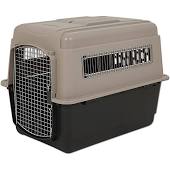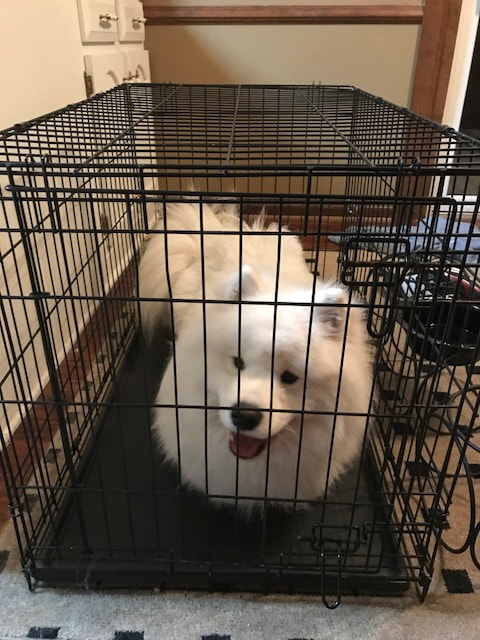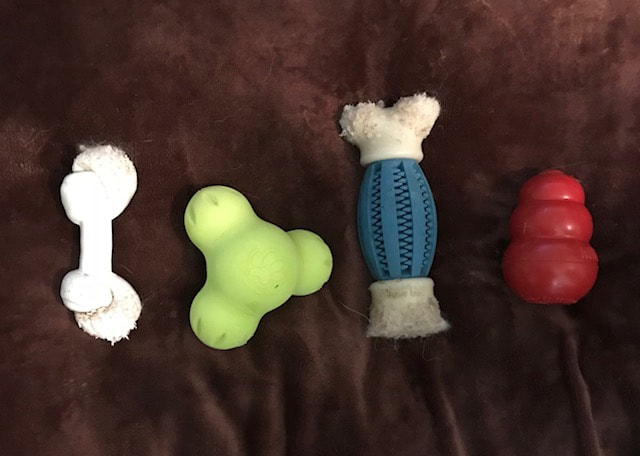CRATE TRAINING

Reasons to Crate Train a Dog
There are many benefits to training a puppy or adult dog to use a crate. Life is better for both canine and human as the crate solves many common problems for cohabitation dogs and families. Here are a just a few:
Choosing the Size and Type of Crate
There are different descriptions of "crate" when referring to restricting the space a puppy or adult dog has when left home alone. In general puppies do well when confined to a "kennel" which can be wire or hard plastic. Many adult dogs prefer a kennel when left home alone, but some do well when restricted to a small room in the home such as a laundry room, mud room, or kitchen. Some adult dogs will remain in a room with a baby gate setting a visual and physical boundary while others may need the door closed. Another option is a x-pen which is similar to a playpen for a child.
The size of the crate depends on the size of the dog. In general allow for enough room to stand up, turn around and lie down. When purchasing a crate for a puppy consider the size the puppy will be as an adult to prevent needing a new crate after the puppy grows. Many crates will come with a divider so the size of the crate can increase as the puppy grows.
Where to Place the Crate
A crate can be located anywhere in the home. Careful consideration of placement can help both the dog and people benefit as much as possible from the use of the crate. The goals of the family and the needs of the dog will determine the best location. Keep in mind that it can be moved. Don't be afraid to experiment with different locations. If the dog begins distress barking in one location the crate can be moved to an area where the rest of the family can be seen. If the crate ends up being in the way of family activities look for a more convenient place.
Tips for Successful Crate Training
There are many benefits to training a puppy or adult dog to use a crate. Life is better for both canine and human as the crate solves many common problems for cohabitation dogs and families. Here are a just a few:
- Crate training your puppy or adult dog provides safety and security.
- It prevents inappropriate behaviors while families are busy. Most dogs will be left home alone while people are at work, school, shopping, or recreational activities. Crate training prevents destructive behaviors such as chewing, eating inappropriate items and eliminating inside the house.
- Surprisingly, most dogs feel comfortable, have less stress, and relax while home alone in a crate. Many will retreat to the crate even when the family is home. They feel safe to relax, nap and eat in the crate.
- Crate training helps with housebreaking. By instinct most dogs will avoid eliminating in their sleeping and eating areas unless left in the crate too long or if they are ill.
Choosing the Size and Type of Crate
There are different descriptions of "crate" when referring to restricting the space a puppy or adult dog has when left home alone. In general puppies do well when confined to a "kennel" which can be wire or hard plastic. Many adult dogs prefer a kennel when left home alone, but some do well when restricted to a small room in the home such as a laundry room, mud room, or kitchen. Some adult dogs will remain in a room with a baby gate setting a visual and physical boundary while others may need the door closed. Another option is a x-pen which is similar to a playpen for a child.
The size of the crate depends on the size of the dog. In general allow for enough room to stand up, turn around and lie down. When purchasing a crate for a puppy consider the size the puppy will be as an adult to prevent needing a new crate after the puppy grows. Many crates will come with a divider so the size of the crate can increase as the puppy grows.
Where to Place the Crate
A crate can be located anywhere in the home. Careful consideration of placement can help both the dog and people benefit as much as possible from the use of the crate. The goals of the family and the needs of the dog will determine the best location. Keep in mind that it can be moved. Don't be afraid to experiment with different locations. If the dog begins distress barking in one location the crate can be moved to an area where the rest of the family can be seen. If the crate ends up being in the way of family activities look for a more convenient place.
Tips for Successful Crate Training
- Make the crate a positive place for the puppy or adult dog. Do not use the crate for discipline. Instead associate as many positive experiences as possible.
- Make sure the dog's needs of exploration, play, food, water and elimination have been met before and while in the crate. The dog will transition better to the crate if the crate becomes a location for these positive routines. For example, feed the dog in the crate, provide a special treat, or provide a safe, special chew bone when you put the dog in the crate. For puppies avoid plush toys, towels or bedding as the puppy might chew and ingest these items. This could cause serious illness or a foreign body blockage that may require surgical removal. If the adult dog or newly adopted dog has a history of chewing items make sure the items in the crate are indestructible, and safe for the adult dog.
- Leave on a radio or the television to help prevent distress barking when the puppy or adult dog is left home alone. An environmental noise can startle the dog leading to barking. The radio or television can prevent the puppy or adult dog from hearing a loud noise.
- Release the dog when s/he is quiet can prevent excessive, excited barking. The quiet behavior is rewarded when you let the dog out of the crate to interact with you.
- Be careful to not reinforce the distress barking. When a family member goes to the distress barking dog the barking is reinforced. After all, the dog is likely barking as a way to call out for the family. As newborns the puppies cry until the mother moves the puppies closer to her or the other litter-mates. This natural behavior can end up reinforced. It's much easier to prevent this reinforcement early on than to retrain the desired behavior later.
With proper training, a crate can be the answer to many problems dog owners face. A little extra planning plus persistent and consistent training ensure success for both the dog and family members. Consider the needs of the dog and consider the needs of the rest of the family when setting goals for crate training. As with any desired behavior, use positive reinforcement to shape the behaviors you'd like from your dog. Crate training is a win for both dog and family!

